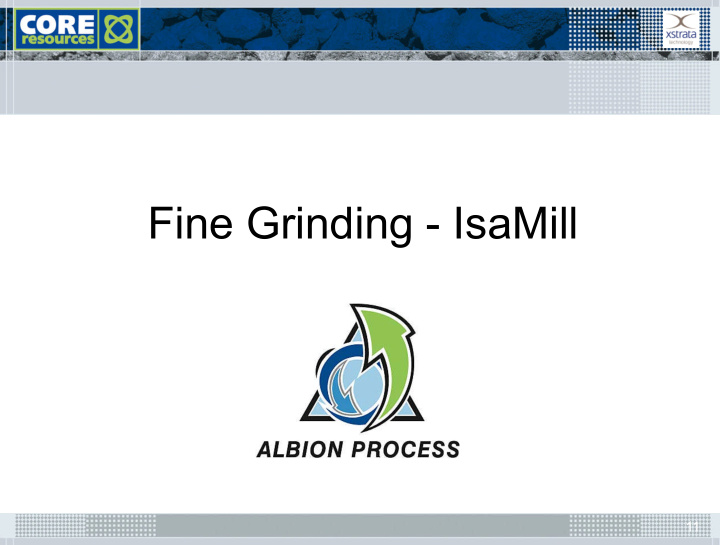



Fine Grinding - IsaMill 11
Fine Grinding • There are several commercially available fine grinding technologies including: Xstrata Technology- IsaMIll Metso- Detritor Metso- Vertimill • It is not mandated to use IsaMill equipment for the Albion Process, although this technology would be considered the most advanced (>80 mills installed in 16 countries with >130 MW installed power) • Key requirements of fine grinding is efficient grinding of product to P 80 of 10 µ m to12 µ m having a tight particle size distribution 12
Fine Grinding • Typical refractory gold IsaMill fine grind window 25-90 kWh/t to mill pyrite concentrates to P 80 10-12 µ m 110 90 High - 90 kWh/tonne Specific Energy (kWh/t) 70 Mean - 60 kWh/tonne 50 30 Low - 25 kWh/tonne 10 Size (um) 1 10 100 13
Fine Grinding • Commercial IsaMill Installations Operation: KCGM Owner: Newmont Mining Corp Location: Western Australia Treatment Rate: 12 tph pyrite concentrate Grind Size: 10-12 µ m (ahead of CIL) Equipment: 1 x M3000 IsaMill 14
Fine Grinding • Commercial IsaMill Installations Operation: Kumtor Owner: Centerra Location: Kyrgyzstan Treatment Rate: 30-35 tph pyrite concentrate Grind Size: 10-12 µ m (ahead of CIL) Equipment: 1 x M10000 IsaMill 15
Fine Grinding • Commercial IsaMill Installations Operation: Macraes Owner: Oceana Gold Limited Location: New Zealand Treatment Rate: 12 tph concentrate Grind Size: 15 µ m (ahead of POX) Equipment: 1 x M1000 IsaMill 16
Sulphide Oxidation – Albion Process 17
Sulphide Oxidation • Within the Albion Process there are two process chemistries that can be employed: Acid Albion Leaching (AAL) Neutral Albion Leaching (NAL) • Acid Albion Leach process: sulphide oxidation occurs predominately via the action of ferric ion intermediates: Step 1 – MS + Fe 2 (SO 4 ) 3 = MSO 4 + 2FeSO 4 + S o Step 2 – S o + 3Fe 2 (SO 4 ) 3 = 4H 2 SO 4 + 6FeSO 4 Albion Process leach conditions can be controlled to vary the extent of these reactions such that the leaching step can usually be operated without the addition of acid from external sources • This presentation will focus on Neutral Albion Leaching for treatment of pyrite bound refractory gold 18
Sulphide Oxidation • Neutral Albion Leach process: oxidative leaching of pyrite destroys the sulphide matrix to liberate ferric ions and sulphuric acid. FeS 2 + 15/4O 2 + 1/2H 2 O = 1/2Fe 2 (SO 4 ) 3 + 1/2H 2 SO 4 • Ferric ions and acid are neutralized insitu to form goethite and gypsum by continual addition of limestone slurry. The overall reaction becomes: FeS 2 + 15/4O 2 + 9/2H 2 O + 2CaCO 3 = FeO.OH + 2CaSO 4 .2H 2 O + CO 2 • Typical operating conditions: pH 5.5 and 95-98 o C (depends on site elevation and sulphide oxidation rate) 19
Sulphide Oxidation • Advantages & Features of Neutral Albion Leach : 1. No elemental sulphur formation a. No passivation b. Reduced cyanide consumption c. Reduced thiocyanate production (CN destruction) 2. Goethite major iron precipitate a. Minimizing silver losses to jarosite b. No ferri/ferro cyanide formation (CN consumption minimized) 3. Low back ground salt levels in solution a. Minimizes scale formation due low degree of super saturation (simply operation and maintenance) b. Enhances oxygen solubility and oxygen mass transfer 4. Eliminates the need for CCD and external dedicated neutralization circuits (reduced capital) 20
Recommend
More recommend